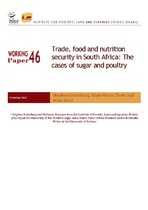| dc.contributor.author | Greenberg, Stephen | |
| dc.contributor.author | Thow, Anne Marie | |
| dc.contributor.author | Hara, Mafaniso | |
| dc.date.accessioned | 2019-03-14T12:17:30Z | |
| dc.date.available | 2019-03-14T12:17:30Z | |
| dc.date.issued | 2017-10 | |
| dc.identifier.citation | Greenberg et al (2017) 'Trade, food and nutrition security in South Africa: The cases of sugar and poultry’, Working Paper 46. PLAAS, UWC: Cape Town. | en_US |
| dc.identifier.uri | http://hdl.handle.net/10566/4525 | |
| dc.description.abstract | The purpose of this paper is to consider the role that trade plays in food and nutrition security
in South Africa. Despite an established commercial food system, South Africans experience high
levels of food and nutrition insecurity – both under-nutrition and rising rates of diet-related
non-communicable diseases (NCDs). The Food and Agriculture Organization of the United
Nations (FAO) defines food security as ‘a situation that exists when all people, at all times, have
physical, social and economic access to sufficient, safe and nutritious food that meets their
dietary needs and food preferences for an active and healthy life’1. This paper considers three
dimensions of food security – availability, access and nutrition – and unpacks the role of trade
across these dimensions at policy level and in practice in sugar and poultry, two key
commodities in the food basket of resource-poor South African households.
According to the South African National Health and Nutrition Examination Survey (SANHANES-
1) (Shisana et al., 2013:10), 26% of households surveyed nationally reported experiencing
hunger, with another 28% of households at risk of hunger. Households in ‘urban informal’
contexts, followed by those in rural formal and then rural informal settings experienced the
highest levels of food insecurity. Eastern Cape and Limpopo are the provinces with the highest
proportion of food insecure people. The 2005 National Consumption Survey showed that 18%
of children in South Africa were stunted, with rural and then urban informal areas most
severely affected. ‘Wasting’ (from poor nutrition quality, rather than insufficient food) affected
4.5% of South African children, with 9.3% of children being underweight (DAFF, 2014:9). | en_US |
| dc.language.iso | en | en_US |
| dc.publisher | Institute for Poverty, Land and Agrarian Studies, University of the Western Cape | en_US |
| dc.relation.ispartofseries | Working Paper;46 | |
| dc.subject | Trade | en_US |
| dc.subject | Food and nutrition security | en_US |
| dc.subject | Food insecurity | en_US |
| dc.subject | Sugar | en_US |
| dc.subject | Poultry | en_US |
| dc.title | Trade, food and nutrition security in South Africa: The cases of sugar and poultry | en_US |
| dc.type | Working Paper | en_US |

